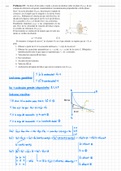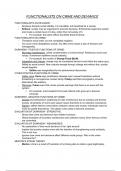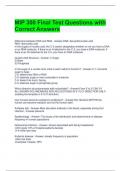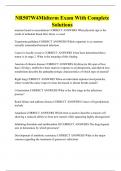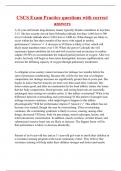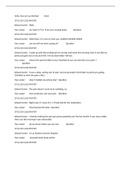Case 4 Gut brain interaction for survival
Learning goals:
Which regions of the brain regulate appetite control in general?
o Regulation mechanisms of appetite → stretch of stomach (focus on hormones) (CCK,
GLP1, PYY, ghrelin, leptin)
MC4R - endogenous molecule receptor
Melaton - MSH
The other nuclei involved in the regulation of appetite are
o The dorsomedial hypothalamic nucleus (DMH), which is involved in stimulating
gastrointestinal activity.
o The ventromedial hypothalamic nucleus (VMH), which is involved in neural signals
that elicit the sensations of satiety.
o The lateral hypothalamic area (LH) is responsible for transmitting orexigenic signals
(desire for food intake) and loss of this region results in starvation.
o The medical hypothalamic nucleus (VMH) is responsible for the sensations of satiety
and lesions in these regions of the hypothalamus result in hyperphagia (excessive
hunger) and obesity
Mechanisms of food reward
1. Starts by oral taste receptor cells which send information to the NTS by afferent
sensory fibres.
2. The NTS transports taste information to the hind-, mid- and forebrain, nucleus
accumbens, striatum, thalamus and cerebral cortex. They all collectively sense
different tastes and textures
3. Higher processing happens in primary taste neurons in the insular cortex with NTS
neurons
4. These cells project to secondary taste neurons in the orbitofrontal cortex that
integrate taste information with relevant olfactory, visual and cognitive inputs
Reduced firing of secondary taste neurons diminishes the reward value of foods and
contributes to meal termination via motor outputs
PYY is an enteric hormone that can reduce food intake. Plasma levels decline in advance of
meals, levels of ghrelin rise shortly before meals and fall on feeding.
GLP1, same as CCK, PYY, inducing satiety
Glicentin, GLP2, oxyntomodulin, glucagon
GLP2 short bowl syndrome, 50% comparability. Induces food intake
Ghrelin stimulates food intake, weight loss increases ghrelin levels to weight regain.
Hypothalamic arcuate nucleus (ARC)
Nucleus tractus solitarius (NTS)
Brain areas beyond the ARC also probably contribute to leptin's enhancement of the
response to satiety signals, because leptin receptors are present in many brain areas involved
, in food intake control, including the NTS itself and because leptin administration directly into
the NTS reduces food intake. The integration of long-acting homeostatic and short-acting
satiety signals may therefore involve direct actions of leptin on NTS neurons that process
input from vagal afferent fibres, in addition to its effects on neurons in hypothalamus and
elsewhere that project to the NTS
Afferent input in proportion to body fat mass (for example, leptin) enhances the response to satiety
signals such as CCK that are generated in response to food consumption and lead to meal
termination. Whereas the hypothalamus is a key target for leptin action, the satiety effect of CCK
involves activation of vagal afferent fibres that terminate in the NTS.
Integration of these inputs can involve the actions of leptin in the ARC (1) or other hypothalamic
areas (2) involving neurons that project to the NTS (3) and influence the response to CCK (4). In
addition, leptin can act directly in the NTS
Learning goals:
Which regions of the brain regulate appetite control in general?
o Regulation mechanisms of appetite → stretch of stomach (focus on hormones) (CCK,
GLP1, PYY, ghrelin, leptin)
MC4R - endogenous molecule receptor
Melaton - MSH
The other nuclei involved in the regulation of appetite are
o The dorsomedial hypothalamic nucleus (DMH), which is involved in stimulating
gastrointestinal activity.
o The ventromedial hypothalamic nucleus (VMH), which is involved in neural signals
that elicit the sensations of satiety.
o The lateral hypothalamic area (LH) is responsible for transmitting orexigenic signals
(desire for food intake) and loss of this region results in starvation.
o The medical hypothalamic nucleus (VMH) is responsible for the sensations of satiety
and lesions in these regions of the hypothalamus result in hyperphagia (excessive
hunger) and obesity
Mechanisms of food reward
1. Starts by oral taste receptor cells which send information to the NTS by afferent
sensory fibres.
2. The NTS transports taste information to the hind-, mid- and forebrain, nucleus
accumbens, striatum, thalamus and cerebral cortex. They all collectively sense
different tastes and textures
3. Higher processing happens in primary taste neurons in the insular cortex with NTS
neurons
4. These cells project to secondary taste neurons in the orbitofrontal cortex that
integrate taste information with relevant olfactory, visual and cognitive inputs
Reduced firing of secondary taste neurons diminishes the reward value of foods and
contributes to meal termination via motor outputs
PYY is an enteric hormone that can reduce food intake. Plasma levels decline in advance of
meals, levels of ghrelin rise shortly before meals and fall on feeding.
GLP1, same as CCK, PYY, inducing satiety
Glicentin, GLP2, oxyntomodulin, glucagon
GLP2 short bowl syndrome, 50% comparability. Induces food intake
Ghrelin stimulates food intake, weight loss increases ghrelin levels to weight regain.
Hypothalamic arcuate nucleus (ARC)
Nucleus tractus solitarius (NTS)
Brain areas beyond the ARC also probably contribute to leptin's enhancement of the
response to satiety signals, because leptin receptors are present in many brain areas involved
, in food intake control, including the NTS itself and because leptin administration directly into
the NTS reduces food intake. The integration of long-acting homeostatic and short-acting
satiety signals may therefore involve direct actions of leptin on NTS neurons that process
input from vagal afferent fibres, in addition to its effects on neurons in hypothalamus and
elsewhere that project to the NTS
Afferent input in proportion to body fat mass (for example, leptin) enhances the response to satiety
signals such as CCK that are generated in response to food consumption and lead to meal
termination. Whereas the hypothalamus is a key target for leptin action, the satiety effect of CCK
involves activation of vagal afferent fibres that terminate in the NTS.
Integration of these inputs can involve the actions of leptin in the ARC (1) or other hypothalamic
areas (2) involving neurons that project to the NTS (3) and influence the response to CCK (4). In
addition, leptin can act directly in the NTS

